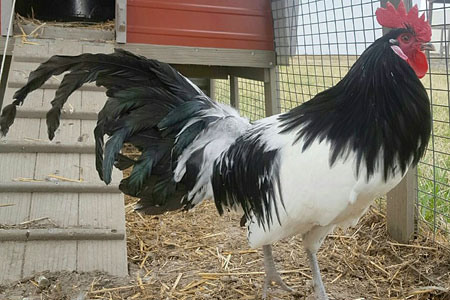
Lakenvelder chickens are an ancient laying breed from the Utrecht area of southern Holland and the neighboring Nordrhein-Westfalen area of Germany. They take their name from the Dutch village of Lakervelt, in a region that favors the color pattern of a white mid section with black extremities. Besides Lakenvelder chickens, examples include goats, rabbits, pigs, and cattle. In the United States we call the pattern Dutch Belted.
Physical Attributes
Lakenvelders are white chickens with black hackles and long, graceful black tails. Although other color patterns exist, this silver pattern is the most common. The Lakenvelder’s true plumage color and markings fully develop after the third molt, making juvenile plumage unreliable as an indicator of how a chicken will look at maturity.
Setting off its striking black-and-white plumage, the Lakenvelder has slate legs and a bright red single comb. Roosters mature to about 5 pounds, hens to about 4 pounds. Silver Lakenvelders arrived in the United States around 1905 and were admitted to the American Standard of Perfection in 1939.
Breed Qualities
Lakenvelder hens begin laying at around 5 months of age, averaging 150 to 200 medium size white or tinted eggs per year. The hens rarely brood.
Lakenvelders are most popular for laying and for exhibition. Being rather smallish, they are not often kept for meat. However, despite being a bit meager, the meat is exceptionally flavorful.
Lakenvelder chickens have good heat tolerance but are not fond of cold weather. Given adequate shelter, though, they do well in most climates.
As an especially energetic breed, Lakenvelders may dominate the more docile breeds in a mixed flock. And they do not like close confinement, which increases their flightiness.
Lakenvelders prefer, instead, to forage widely. Being extremely active and also wary, Lakenvelder chickens make an excellent choice for homegrown free range eggs.
Helpful Links
How to Mix Different Chicken Breeds in One Flock
When To Expect Your Hens to Start Laying
Lakenvelder Chickens Offered by Cackle Hatchery®
And that’s today’s news from the Cackle Coop.
Gail Damerow has written numerous poultry-keeping books, including The Chicken Encyclopedia.

